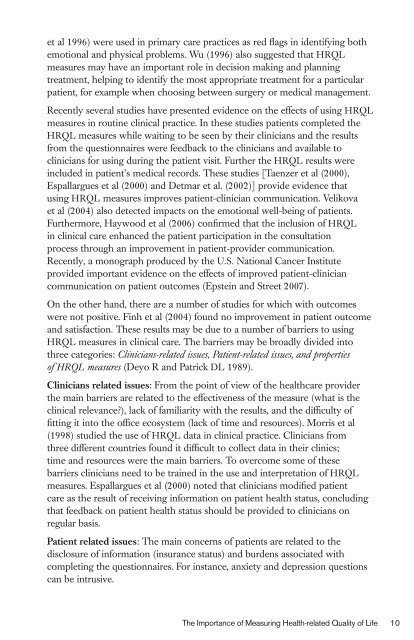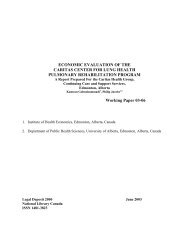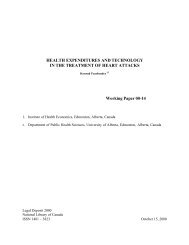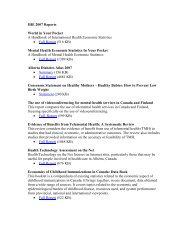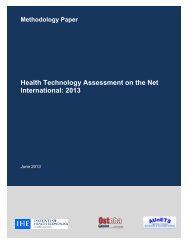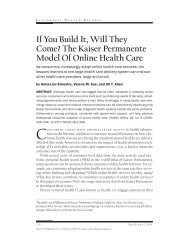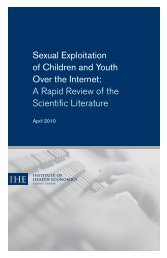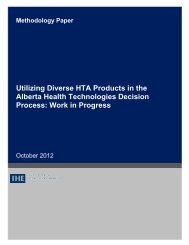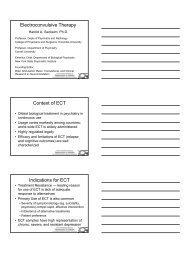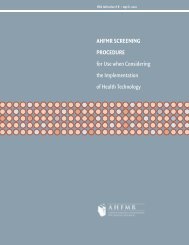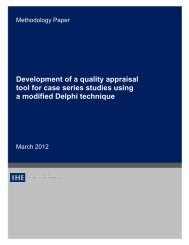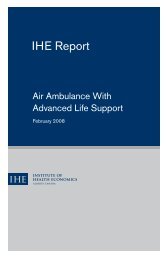IHE Report - Institute of Health Economics
IHE Report - Institute of Health Economics
IHE Report - Institute of Health Economics
- No tags were found...
Create successful ePaper yourself
Turn your PDF publications into a flip-book with our unique Google optimized e-Paper software.
et al 1996) were used in primary care practices as red flags in identifying bothemotional and physical problems. Wu (1996) also suggested that HRQLmeasures may have an important role in decision making and planningtreatment, helping to identify the most appropriate treatment for a particularpatient, for example when choosing between surgery or medical management.Recently several studies have presented evidence on the effects <strong>of</strong> using HRQLmeasures in routine clinical practice. In these studies patients completed theHRQL measures while waiting to be seen by their clinicians and the resultsfrom the questionnaires were feedback to the clinicians and available toclinicians for using during the patient visit. Further the HRQL results wereincluded in patient’s medical records. These studies [Taenzer et al (2000),Espallargues et al (2000) and Detmar et al. (2002)] provide evidence thatusing HRQL measures improves patient-clinician communication. Velikovaet al (2004) also detected impacts on the emotional well-being <strong>of</strong> patients.Furthermore, Haywood et al (2006) confirmed that the inclusion <strong>of</strong> HRQLin clinical care enhanced the patient participation in the consultationprocess through an improvement in patient-provider communication.Recently, a monograph produced by the U.S. National Cancer <strong>Institute</strong>provided important evidence on the effects <strong>of</strong> improved patient-cliniciancommunication on patient outcomes (Epstein and Street 2007).On the other hand, there are a number <strong>of</strong> studies for which with outcomeswere not positive. Finh et al (2004) found no improvement in patient outcomeand satisfaction. These results may be due to a number <strong>of</strong> barriers to usingHRQL measures in clinical care. The barriers may be broadly divided intothree categories: Clinicians-related issues, Patient-related issues, and properties<strong>of</strong> HRQL measures (Deyo R and Patrick DL 1989).Clinicians related issues: From the point <strong>of</strong> view <strong>of</strong> the healthcare providerthe main barriers are related to the effectiveness <strong>of</strong> the measure (what is theclinical relevance?), lack <strong>of</strong> familiarity with the results, and the difficulty <strong>of</strong>fitting it into the <strong>of</strong>fice ecosystem (lack <strong>of</strong> time and resources). Morris et al(1998) studied the use <strong>of</strong> HRQL data in clinical practice. Clinicians fromthree different countries found it difficult to collect data in their clinics;time and resources were the main barriers. To overcome some <strong>of</strong> thesebarriers clinicians need to be trained in the use and interpretation <strong>of</strong> HRQLmeasures. Espallargues et al (2000) noted that clinicians modified patientcare as the result <strong>of</strong> receiving information on patient health status, concludingthat feedback on patient health status should be provided to clinicians onregular basis.Patient related issues: The main concerns <strong>of</strong> patients are related to thedisclosure <strong>of</strong> information (insurance status) and burdens associated withcompleting the questionnaires. For instance, anxiety and depression questionscan be intrusive.The Importance <strong>of</strong> Measuring <strong>Health</strong>-related Quality <strong>of</strong> Life 10


